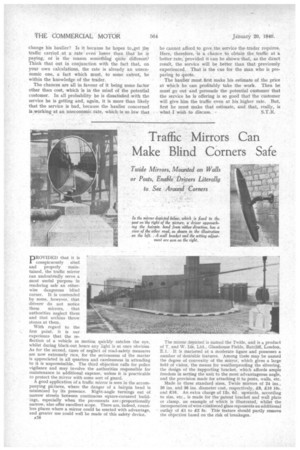Traffic Mirrors Can Make Blind Corners Safe
Page 38

If you've noticed an error in this article please click here to report it so we can fix it.
Twide Mirrors, Mounted on Walls or Posts, Enable Drivers Literally to See Around Corners
ROVIDED that it is
conspicuously sited and properly maintained, the traffic mirror can undoubtedly serve a most useful purpose in rendering safe an otherwise dangerous blind corner. It is contended by some, however, that drivers' do not notice these mirrors, that authorities neglect them and that urchins throw stones at them.
With regard to the first point, it is our experience that the reflection of a vehicle in motion quickly catches the eye, whilst during black-out hours any light is at once obvious. As for the second, cases of neglect of road-safety measures are now extremely rate, for the seriousness of the matter is appreciated in all quarters and carelessness in attending to it is unpermissible. The third objection calls for police vigilance and may involve the authorities responsible for maintenance in additional expense, unless it is practicable to protect the mirror with some sort of guard. A good application of a traffic mirror is seen in the accompanying pictures, where the danger of a hairpin bend is minimized by its presence. Right-angle turnings out of narrow streets between continuous square-cornered buildings, especially when the pavements are proportionally narrow, also offer excellent scope. There are, indeed, countless places where a mirror could be erected with advantage, and greater use could well be made of this safety device. A28
The mirror depicted is named the Twide, and is a product of T. and W. lde, Ltd., Glasshouse Fields, Ratcliff, London, E.1. It is marketed at a moderate figure and possesses a number of desirable features. Among theSe may be named the degree of convexity of the mirror, which gives a large field of vision, the means for weatherproofing the silvering, the design of the gupporting bracket, which affords ample freedom in setting the unit to the most advantageous angle, and the provision made for attaching it to posts, walls, etc.
Made in three standard sizes, Twide mirrors of 24 ins., 30 ins. and 36 ins, diameter cost, respectively, £8, £10 10s.. and £16. An extra charge of 12s. 6d. upwards, according to size, etc., is made for the patent bracket and wall plate or clamp, an example of which is illustrated, whilst the incorporation of wire-rainforced glass represents an additional outlay of El to £2 Ss. This feature should partly remove the objection based on the risk of breakages.




























































